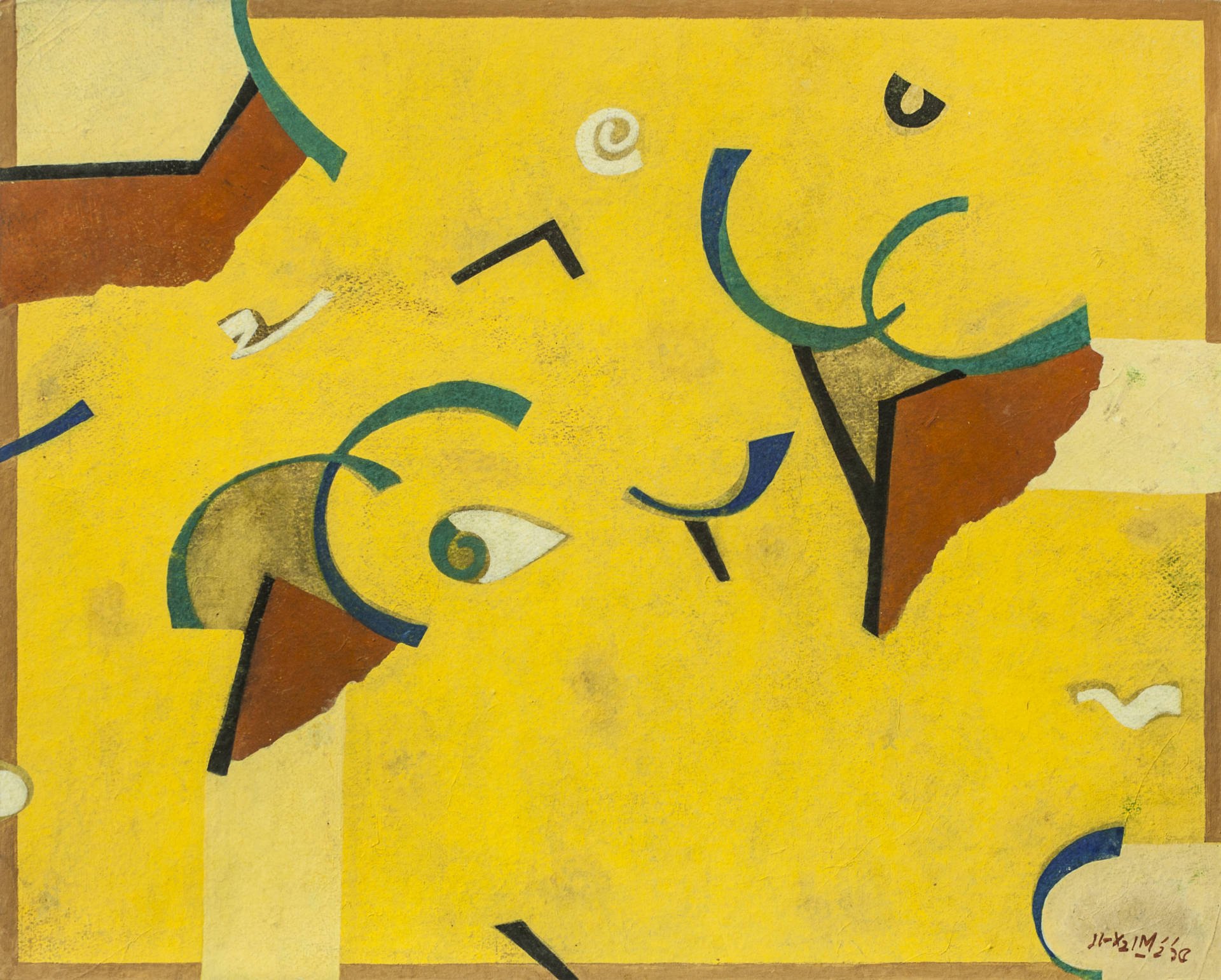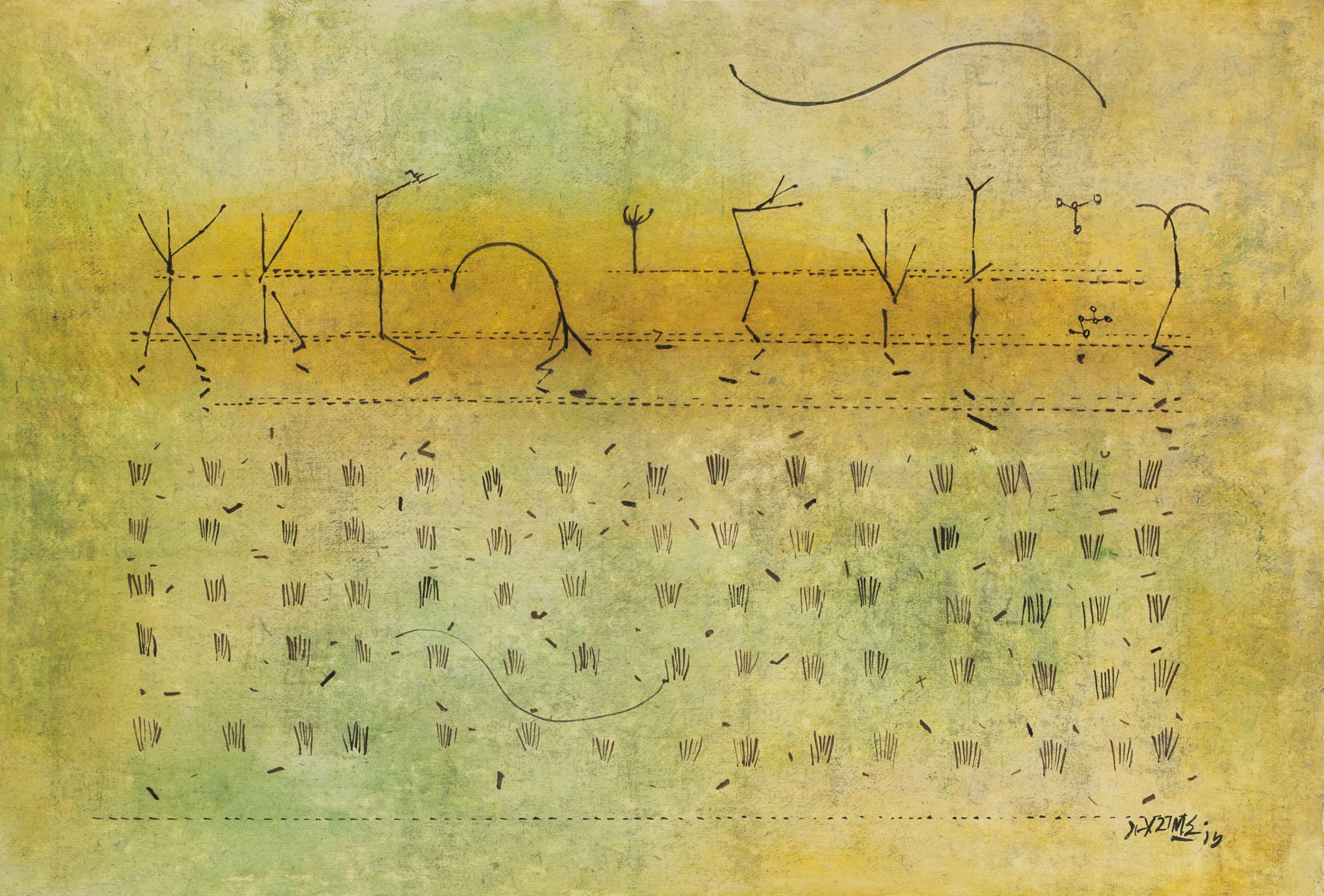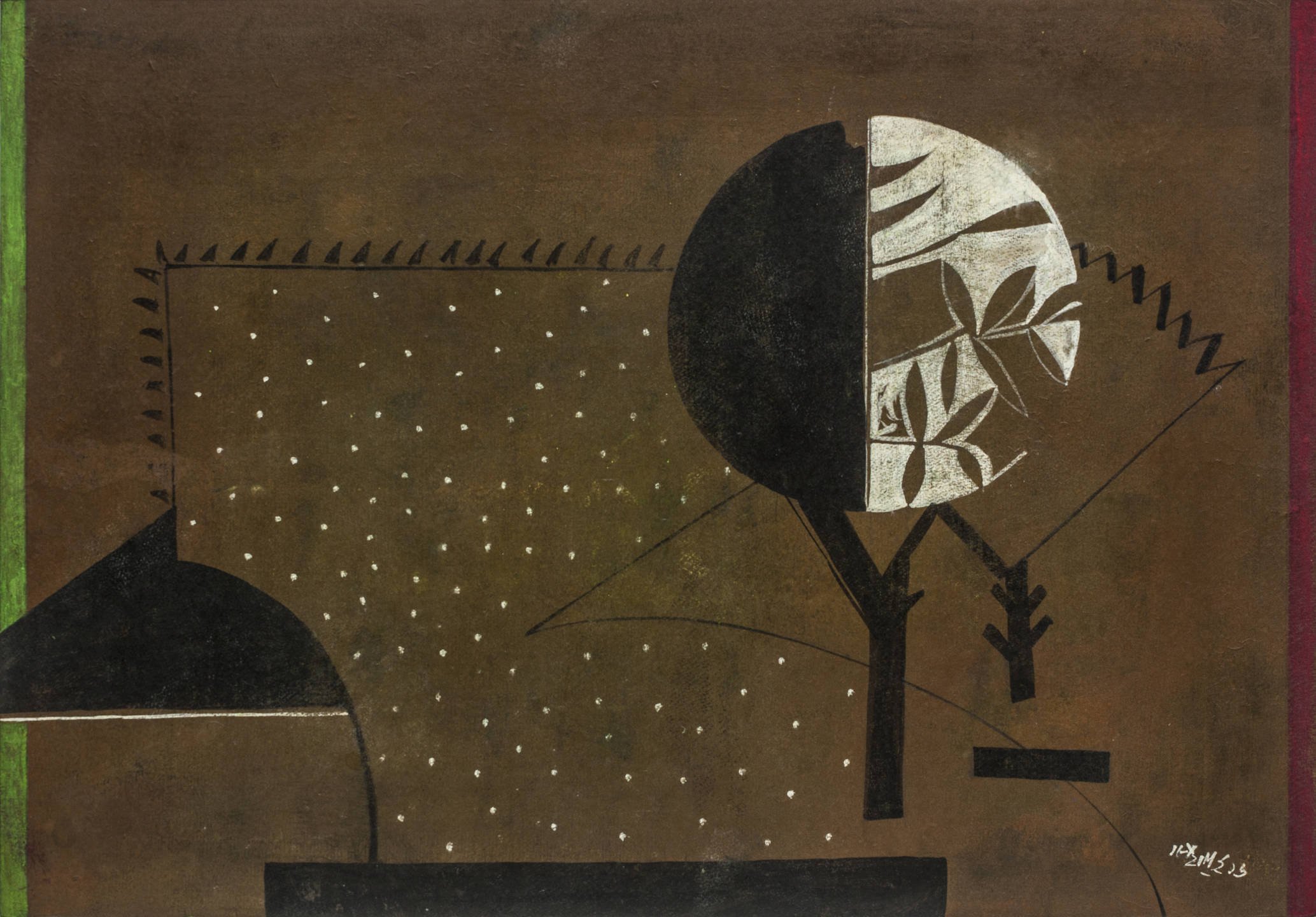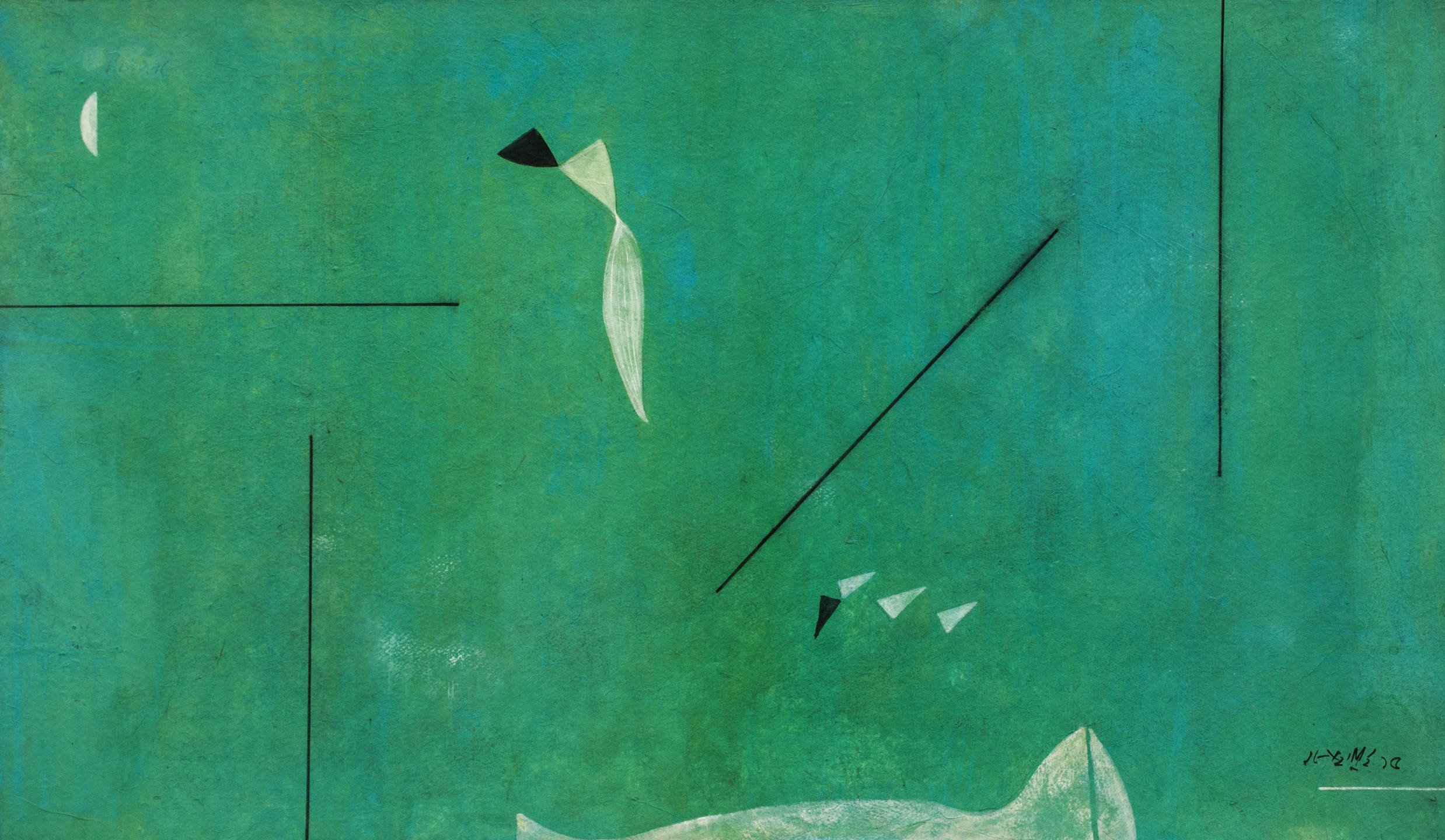
The Feeling Eye by Ganesh Haloi
December 5 - December 30, 2016 at Akar Prakar, Kolkata
Colour has reached a new dimension through his works, colour that has found its own space and united to form its own unique language.
Yet he insists that “the space tension with the object has to be maintained.” A clear understanding of space and colour gravity is expressed here. Haloi through his years of practice maintained a faith in Indian spirituality and metaphysics which propounds the belief that the world was created by non-being and will finally dissolve into its non-beingness. And man was created to experience the duality of being and non-being, the materialistic and spiritual, the active and passive, illusion and reality. He always resisted the idea of complete abstraction and he firmly believed in the notion of texture, matter, colour and their relations. Thus he was exploring these relations to finally achieve a balance and an order. A balance that keeps the universe in order, from its macro-workings in invisible spaces to its micro-working on this planet that is visible. An order that has been organically structuring and restructuring itself through aeons of evolution and discovery, just to maintain this equillibrium. We experience this order and its balance in our daily lives and strive to maintain it so as to exist. So significant is its place in our lives. From its deep psychic and psochological necessity to a more materialistic one, balance and order is what governs our core values and reason of existence. To experience it and maintain it through one’s life and art is a realisation worth reckoning. It is important here to quote a passage from the artist’s diary where he identifies each colour with his own life experience — a symbolic representation of his practice.
Black is my faith,
Blue is the wideness,
Green is the field,
Red is my seed,
White is the wildness,
Yellow is the sunshine,
I am composite of these colours,
Which ultimately leads me to an unknown destiny.
Jesal Thacker
Some of the earth shades exposed in the artist’s work allude to the contours of baked clay—in fact, his home and studio remain filled with collections of clay figurines and wood crafted objects that compose an archive of living traditions. These cultural artifacts expose Haloi’s cultivated understanding of how modernist idiom remains uniquely connected to artisanal vocabularies and vernacular knowledge from across the Indian subcontinent.
Across his painterly work especially in the past decade, rhythm construction becomes strongly manifest as Haloi’s strokes begin to appear as score lines for a song composition—with secret scripts that appear to settle upon grassy patches and golden yellow ripe meadows. These are Kandinsky like, where colour flows resonate as visual chords and elicit synesthetic encounter.
Haloi has cultivated a sensorial practice of seeing which considers that the unknown element is inevitably encompassed in the composition of the known—like hidden galaxies that remain beyond calculation to the human eye, nevertheless lighting up the celestial skies under which we survive. This artist charts terrains of the sensed, rather than remaining controlled by a frontier of directly consumable reality and thus, he builds image constellations as a limitless space. There is no way to remain unmoved when in the company of Haloi’s paintings; I find that they enliven me, presenting a complex structure of feeling and planetary belonging within the dark vulnerability of our present.
Natasha Ginwala
Ganesh Haloi | Untitled | Gouache on Nepali paper Pasted on board | 14.25 x 18.5 in | 2015
Ganesh Haloi | Untitled | Gouache on Nepali paper Pasted on board | 18.5 x 22.25 in | 2015
Ganesh Haloi | Untitled | Gouache on Nepali paper Pasted on board | 18.5 x 26.75 in | 2014
Ganesh Haloi | Untitled | Gouache on Nepali paper Pasted on board | 18.5 x 28.25 in | 2014
Ganesh Haloi | Untitled | Gouache on Nepali paper Pasted on board | 16 x 19.75 in | 2015
Ganesh Haloi | Untitled | Gouache on Nepali paper Pasted on board | 16 x 19.75 in | 2015
Ganesh Haloi | Untitled | Gouache on Nepali paper Pasted on board | 16 x 19.75 in | 2015
Ganesh Haloi | Untitled | Gouache on Nepali paper Pasted on board | 14.25 x 18.5 in | 2015
Ganesh Haloi | Untitled | Gouache on Nepali paper Pasted on board | 18.5 x 29.5 in | 2014
Ganesh Haloi | Untitled | Tempera on paper Pasted on board | 22 x 31.75 in | 2015
Ganesh Haloi | Untitled | Gouache on Nepali paper Pasted on board | 18.5 x 22.25 in | 2015
Ganesh Haloi | Untitled | Gouache on Nepali paper Pasted on board | 27.75 x 18.5 in | 2014
Ganesh Haloi | Untitled | Gouache on board | 21 x 30 in | 2016
Ganesh Haloi | Untitled | Tempera on paper Pasted on board | 16 x 19.75 in | 2015
Ganesh Haloi | Untitled | Tempera on paper Pasted on board | 20 x 29.5 in | 2016
Ganesh Haloi | Untitled | Gouache on board | 17.75 x 25.75 in | 2016
Ganesh Haloi | Untitled | Gouache on board | 20 x 29.75 in | 2016
Ganesh Haloi | Untitled | Gouache on board | 19.5 x 29.5 in | 2016
Ganesh Haloi | Untitled | Gouache on Nepali paper Pasted on board | 16 x 27.5 in | 2015
Ganesh Haloi | Untitled | Tempera on paper Pasted on board | 16 x 27.25 in | 2015
Ganesh Haloi | Untitled | Gouache on Nepali paper Pasted on board | 21 x 27 in | 2009
Ganesh Haloi | Untitled | Gouache on Nepali paper Pasted on board | 22 x 31.75 in | 2009
Ganesh Haloi | Untitled | Gouache on board | 19.75 x 28,25 in | 2016
Ganesh Haloi | Untitled | Gouache on board | 19.5 x 29.5 in | 2016
Ganesh Haloi | Untitled | Gouache on hand made paper | 18.75 x 32.25 in | 2016
Ganesh Haloi | Untitled | Gouache on hand made paper | 24.24 x 31.5 in | 2015
Ganesh Haloi | Untitled | Gouache on hand made paper | 18.75 x 32.25 in | 2015
Ganesh Haloi | Untitled | Gouache on hand made paper | 18.75 x 32.25 in | 2015
Ganesh Haloi | Untitled | Gouache on hand made paper | 18.75 x 32.25 in | 2015
Ganesh Haloi | Untitled | Gouache on board | 19.75 x 29.5 in | 2016
Ganesh Haloi
Ganesh Haloi, a 20th century artist, was born in Jamalpur, Mymensingh, now in Bangladesh in 1936. He moved to Calcutta after the Partition in 1950 and was therefore entrenched in the polyphonic culture that was struggling for its own freedom and identity. Artists of this generation have been very significant in the shaping of Indian Modern Art as they have been witnesses to India’s resilient culture, its freedom and struggle for its revivalism.Ganesh Haloi’s art stands at the helm of this revival.His Simple gouache on paper express layers of this timeless struggle. The process of creation too is a struggle to compose the space, colour, form, narration. But for Haloi it has always been colour and its space, trying to create a dialogue foe each tone that he lays on the surface. Giving it its own individuality and constructing layers of different tonalities and textures over it. Like a former quilting the land and preparing its seeds for the season. As quoted by Haloi himself about his works, “I try to paint a land that is my own. My land. With my rules. It has no resemblance to nature. It is the struggle to create this land that makes the process of painting interesting. The space tension with the object has to be maintained.”





























